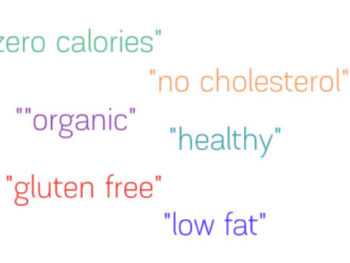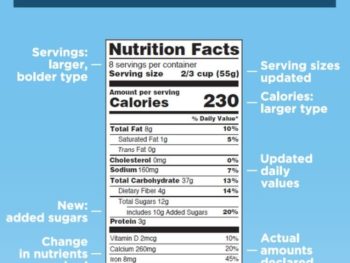For the first time in about a quarter of a century, the Food and Drug Administration (FDA) has updated the Nutrition Facts labels on food packages. Last week, I discussed key changes you can expect to see on the new food labels. This post focuses on the changes to the serving sizes.
Having spent a good part of my career studying changes in the portion sizes of many of our favorite foods, I am particularly interested in the updated serving sizes on the food labels and its implications for you, the consumer.
Here’s some background info: The Nutrition Labeling and Education Act (NLEA) requires that serving sizes listed on Nutrition Facts labels reflect current eating habits. The serving sizes on the labels, therefore, are based on how much we actually eat, not necessarily how much we should eat. The old labels were well behind the times.
FDA looked at more recent dietary intake surveys, which reveal that our consumption patterns have, indeed, changed: we are eating more, or less, of close to 20 percent of foods than we were thirty to forty years ago. For example, Americans now consume larger servings of soda, ice cream, and bagels and smaller portions of yogurt. (Go figure!) Therefore, the food label serving sizes are increasing for ice cream, soda, and some bread products; decreasing for yogurt; and staying the same for pizza and burritos. Just to name a few.
Using typical serving sizes is important because the serving size has a domino effect when it comes to the rest of the numbers on the label. A bigger serving size will reflect more calories— along with more sodium, sugar, and other nutrients—on the label. Now, when you skim the label on your favorite pint of ice cream, you might notice that the serving size is 2/3 cup instead of 1/2 cup. Likewise, the number of calories and grams of fat and sugar have also increased.
But remember: the FDA is not suggesting that you eat a larger serving of ice cream. The purpose of increasing the serving size is to give you a clear picture of how many calories—and nutrients—you would consume if you did eat a typical serving size.
Do Americans understand food label serving sizes?
The flip side of displaying typical serving sizes on the label is that many people believe that the serving size denotes how much they should eat. Note to self: Serving sizes on Nutrition Facts labels reflect what people typically eat in a sitting. And since most people eat too much, the serving size on the label is not necessarily the amount you should eat!
A Georgetown University McDonough School of Business study found that the new labels worked as intended: participants had a better understanding of how many calories were in a package and ate less of foods they perceived as being unhealthy. A study conducted at New York University’s Stern School of Business and Duke University found the opposite: most people—nearly 80 percent—thought the serving size on a label was a recommended serving size, or what you should eat, while only 20 percent knew it reflects how much people typically consume. In the same study, people who saw the new labels ate 41 percent more cookies and served nearly 30 percent more cheese crackers to their guests.
Next time you glance at the Nutrition Facts label of your favorite packaged food, keep this info in mind.
I devote an entire chapter to the updated food labels in my book Finally Full, Finally Slim. Check out the various versions (soft cover came out in January 2020!) and order a copy for yourself or a friend.





 New year, new food labels! Key changes you can expect to see on your favorite food package
New year, new food labels! Key changes you can expect to see on your favorite food package